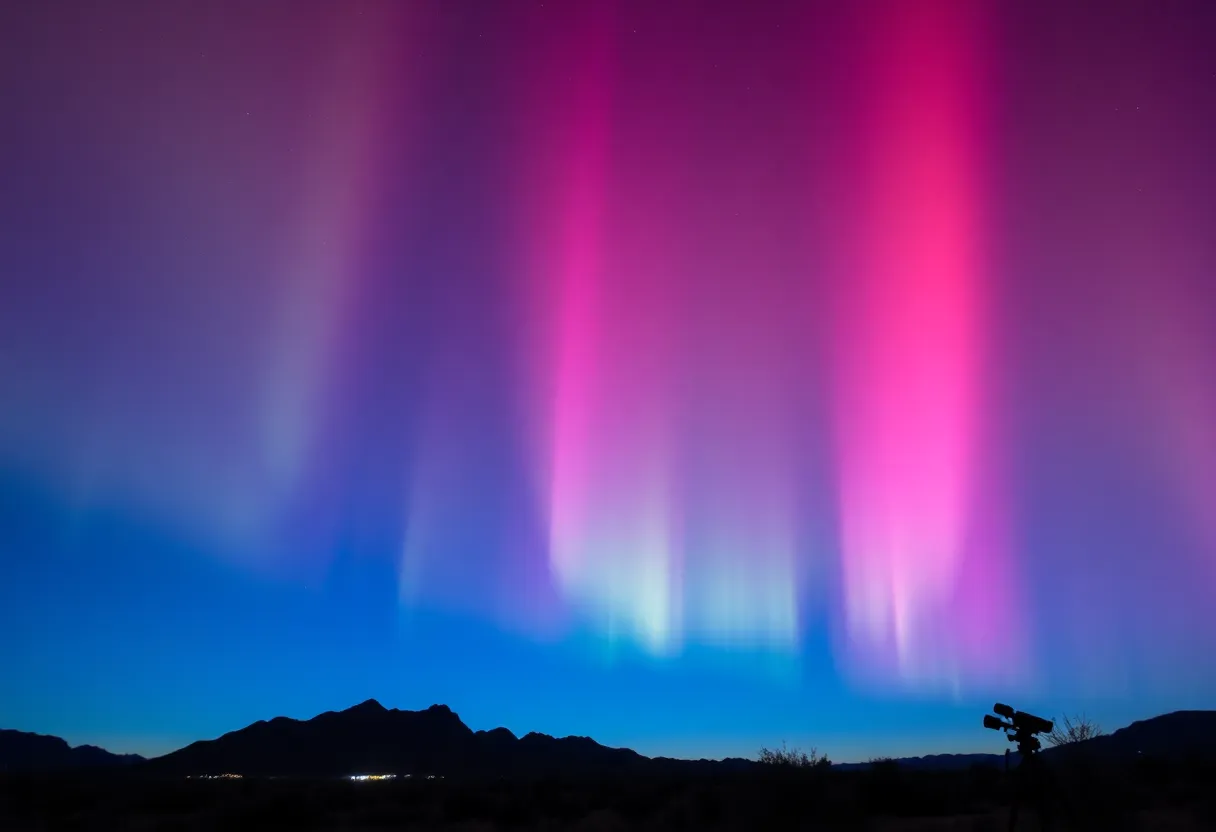Tucson, October 21, 2025
On October 20, Tucson experienced significant solar activity as two M-class flares erupted from sunspot region AR3664. This resulted in moderate geomagnetic storms that produced faint auroras, captivating local observers and amateur astronomers. While there were concerns about potential radio blackouts, the impacts were minimal, allowing daily life to continue without major disruptions. As we approach a solar maximum in 2025, such phenomena may become more frequent, inviting increased interest in solar activity’s effects on Earth.
Solar Activity Spikes in Tucson
In Tucson, solar activity reached notable levels on October 20 when two M-class solar flares erupted from the sunspot region AR3664. This event triggered moderate geomagnetic storms that produced faint auroras visible in the area, drawing interest from local observers.
The flares caused temporary disturbances, including potential radio blackouts, but no significant disruptions to daily life or infrastructure occurred. Scientists continue to track these solar events to assess any ongoing risks to satellites and power grids.
Amateur astronomers gathered at sites like Mount Lemmon to view the auroras, highlighting the sun’s natural cycles and their increasing activity as the solar maximum approaches in 2025.
Details of the Solar Event
The two M-class flares from sunspot region AR3664 were a key part of the recent spike in solar activity. M-class flares are moderate-strength solar explosions that release energy and particles into space, often leading to geomagnetic effects on Earth. On October 20, these flares resulted in moderate geomagnetic storms, which are disturbances in Earth’s magnetic field caused by solar wind.
In Tucson, the storms manifested as faint auroras, a rare sight in this region. These lights, typically seen in polar areas, appeared due to the interaction between solar particles and Earth’s atmosphere. While the event was visible to the naked eye under clear skies, it did not cause widespread issues.
Potential radio blackouts were a concern, as solar flares can interfere with radio communications by ionizing the upper atmosphere. However, reports indicate that any such effects were minor and short-lived, with normal operations resuming quickly.
Background on Solar Cycles
The sun operates on an 11-year cycle, during which its activity fluctuates from a period of low sunspot numbers to a peak known as the solar maximum. Current observations suggest that the sun is nearing this peak in 2025, which could bring more frequent events like the recent flares.
Sunspot regions, such as AR3664, are areas on the sun’s surface with strong magnetic fields that often produce flares and other activity. These events can affect technology on Earth, including satellites used for communication and navigation, as well as power grids that might experience induced currents from geomagnetic storms.
Scientists monitor solar activity through various tools, including space-based observatories, to predict and mitigate potential impacts. The recent event in Tucson serves as a reminder of the sun’s dynamic nature and its influence on our planet, even if the effects are usually mild.
While solar flares are common during active periods, the visibility of auroras in Tucson underscores the global reach of these phenomena. The gathering of amateur astronomers at Mount Lemmon not only provided a unique viewing opportunity but also emphasized public interest in space weather. This interest helps raise awareness about the sun’s role in Earth’s environment and the importance of ongoing research.
Overall, the October 20 event was a textbook example of how solar activity can create visible and measurable effects without causing major harm. As the sun approaches its 2025 peak, similar occurrences may become more frequent, prompting increased vigilance from experts.
More broadly, understanding these events is crucial for protecting modern infrastructure. For instance, satellites orbiting Earth could face temporary disruptions from charged particles, and power grids in various regions might need safeguards against geomagnetic-induced currents. In Tucson, the faint auroras offered a peaceful spectacle, contrasting with the potential risks elsewhere.
This incident highlights the interconnectedness of solar phenomena and earthly systems. By studying these events, researchers aim to improve forecasts and reduce vulnerabilities, ensuring that future spikes in activity are managed effectively.
In summary, the solar activity on October 20 provided a fascinating glimpse into the sun’s behavior, with Tucson at the center of local observations. As we move closer to the solar maximum, events like this will likely continue, offering both challenges and opportunities for scientific exploration.
To provide more context, solar flares are classified by their intensity, with M-class being moderate but capable of producing effects like those seen recently. The sunspot region AR3664, named based on its location and sequence, is one of many that form during active solar periods. Geomagnetic storms, while not always visible, can influence atmospheric conditions and even animal migration patterns on Earth.
In Tucson, the clear skies and elevated locations like Mount Lemmon make it an ideal spot for such observations. This event adds to a history of solar monitoring in the area, where community involvement in astronomy helps bridge professional science and public education. As 2025 approaches, experts predict that the sun’s activity will intensify, potentially leading to more frequent aurora sightings and other phenomena in various parts of the world.
The lack of major disruptions from this event is a positive outcome, demonstrating advancements in monitoring and preparedness. Nevertheless, it serves as a call for continued vigilance to handle any escalations in solar activity effectively.
Frequently Asked Questions
- Q: What caused the solar activity spike on October 20?
A: Two M-class flares from sunspot region AR3664 caused the spike, leading to moderate geomagnetic storms. - Q: Were there any visible effects in Tucson?
A: Faint auroras were visible in Tucson due to the geomagnetic storms. - Q: Did the event result in any disruptions?
A: Potential radio blackouts occurred, but no major disruptions happened. - Q: Why are amateur astronomers interested in this event?
A: Amateur astronomers flocked to Mount Lemmon for views, emphasizing the sun’s 11-year cycle nearing its peak in 2025. - Q: What are scientists doing in response?
A: Scientists monitor for impacts on satellites and power grids.
Key Features Chart
| Feature | Description |
|---|---|
| Solar Flares | Two M-class flares from sunspot region AR3664 on October 20 |
| Geomagnetic Storms | Moderate storms causing faint auroras in Tucson |
| Potential Impacts | Radio blackouts, but no major disruptions |
| Public Interest | Amateur astronomers viewing at Mount Lemmon |
| Solar Cycle | Sun’s 11-year cycle nearing peak in 2025 |
| Monitoring | Scientists tracking effects on satellites and power grids |
Deeper Dive: News & Info About This Topic
HERE Resources
Tucson’s Development Boom Driven by Northern Arizona Growth
Major Fire Damages Tucson Business on South Sixth Avenue
Tucson Sees 15% Surge in Small Business Registrations Amid Remote Work Boom
Historic El Rio Hotel Sold for $12 Million in Tucson
Tucson Solar Farm Project Breaks Ground
Local Lawmakers Introduce Safe City Initiative in Tucson
Tucson’s New Venture Program Supports Local Startups
Tucson Breaks Ground on $15 Million Mixed-Use Development
Tucson Sees 4% Surge in Small Business Registrations
El Rio Neighborhood Association Unveils Revitalization Project




